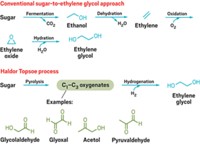Advertisement
Grab your lab coat. Let's get started
Welcome!
Welcome!
Create an account below to get 6 C&EN articles per month, receive newsletters and more - all free.
It seems this is your first time logging in online. Please enter the following information to continue.
As an ACS member you automatically get access to this site. All we need is few more details to create your reading experience.
Not you? Sign in with a different account.
Not you? Sign in with a different account.
ERROR 1
ERROR 1
ERROR 2
ERROR 2
ERROR 2
ERROR 2
ERROR 2
Password and Confirm password must match.
If you have an ACS member number, please enter it here so we can link this account to your membership. (optional)
ERROR 2
ACS values your privacy. By submitting your information, you are gaining access to C&EN and subscribing to our weekly newsletter. We use the information you provide to make your reading experience better, and we will never sell your data to third party members.
Business
A Two-In-One Reactor
Basell is placing a big bet on its new polypropylene technology
by Alexander H. Tullo
May 28, 2007
| A version of this story appeared in
Volume 85, Issue 22

FOUND IN EVERYTHING from take-out soup containers to car bumpers, polypropylene may be the most versatile polymer on Earth. Basell, the world's largest producer of the polymer, aims to push the envelope even further with its Spherizone process technology, which the company claims can make all of the products that its industry workhorse Spheripol process technology can—and then some.
At the heart of Spherizone technology is a reactor loop containing a barrier of liquid propylene that creates two reaction zones. Gases with compositions that can vary by hydrogen content or by the inclusion of co-monomers such as ethylene can be injected into these distinct zones.
As in all polypropylene reactors, the polymer forms around a tiny seed particle of catalyst. The Spheripol process conducts polymerization of propylene in a bulk process followed, for some grades, by a fluidized bed reactor. But in the Spherizone reactor, the catalyst experiences different gas compositions as it circulates around the loop dozens of times, making propylene polymers of distinct compositions on a single particle.
Kaspar Evertz, senior vice president of licensing for Basell, says the intermingling of the different polymer compositions on the same particle yields a homogeneity that doesn't exist with "cascade" polypropylene plants, in which the catalyst particle leaves one reactor for another with different operating conditions.
The bottom line, Evertz says, is better properties. He says polymers made in the Spherizone process show improved stiffness, impact strength, and thermal resistance versus traditional polypropylene. He adds that bimodal resins—polypropylene resins that have a molecular weight distribution with more than one statistical peak—can be created in the process without loss of homogeneity.
The Metallocene and Single-Site Catalyst Monitor, a newsletter published by the Catalyst Group, a consulting firm in Spring House, Pa., ran an article about Spherizone in its March issue. "The ability to closely control molecular weight distribution is of critical importance to the growth of certain polypropylene applications, particularly biaxially oriented polypropylene (BOPP), injection molding, and pipe," it said.
Singling out BOPP, the film used in potato chip bags and the wrapping around cigarette packs, the report said the broad molecular weight distribution, stiffness, and high optical clarity make Spherizone-based resin a strong competitor.
Evertz says the control over molecular weight distribution yields a polypropylene that can be foamed much like polystyrene and can be used for packaging and other applications. He adds that Spherizone has also yielded some new kinds of polypropylene. For instance, it can make "twin random copolymers" by varying ethylene compositions in the two reactor sections. The company is also exploring grades that enhance polypropylene's ability to compete with styrenic and polyester resins.
According to Evertz, Basell has used its own leading Spheripol technology—used in 19.5 million metric tons per year of the world's licensed polypropylene capacity—as the economic benchmark for Spherizone. He says overall costs for the two processes are "about the same."
Moreover, Evertz says Spherizone plants can make all the same products that can be made in the Spheripol process by removing the liquid barrier and allowing for the catalyst to circulate through only one set of reactor conditions.
Basell developed Spherizone in the late 1990s and installed it at its Brindisi, Italy, facility in 2002. Since then, nine licenses have been signed by Basell joint ventures and third parties, adding up to nearly 3.5 million metric tons of capacity. Over the same period, Basell has signed 12 licenses for Spheripol. Generally speaking, Evertz says, conservative players or new entrants to the polypropylene market opt for the proven Spheripol technology. Licensees seeking differentiation favor Spherizone.
THE COMPANY'S second Spherizone plant, at an undisclosed location, has just started up. A plant being built by Samsung Total, a South Korean joint venture between Samsung and Total, will be finished by the end of this year.
All of Basell's joint ventures that have announced plants in recent years are opting for Spherizone instead of Spheripol, Evertz says. For example, Indelpro, Basell's partnership with Mexico's Grupo Alfa, is scheduled to complete a plant in Altamira, Mexico, early next year. Basell joint ventures in Saudi Arabia and Thailand are planning plants based on the technology.
Notwithstanding the company's talk of success, Jorge O. B??hler-Vidal, director of North Brunswick, N.J.-based Polyolefins Consulting, says the technology's impact on the marketplace is still an open question. "It looks like it has additional flexibility," he says. But he adds that true success would become more obvious when the process yields unique products that are widely available.
"You can make all kinds of wonderful things, but what can you do commercially?" Bühler-Vidal asks. For instance, Union Carbide transformed the polyethylene industry with Unipol, its immensely successful technology that spearheaded the linear low-density polyethylene sector.
Basell claims that Spherizone is the next big thing. "We really believe that the extension of the product envelope will reshape the polypropylene industry," Evertz says.





Join the conversation
Contact the reporter
Submit a Letter to the Editor for publication
Engage with us on Twitter